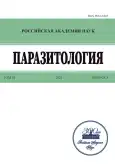Том 58, № 3 (2024)
- Жылы: 2024
- Мақалалар: 5
- URL: https://journals.rcsi.science/0031-1847/issue/view/16361
Бүкіл шығарылым
Articles
On the Origin of soft ticks (Parasitiformes, Ixodoidea, Argasidae)
Аннотация
The origin of the common evolutionary branch of soft and hard ticks is dated to the later Permian, approximately coinciding with the Permian extinction, and divergence of the common branch of Ixodoidea into ancestral forms of Argasidae and Ixodidae occurred in the Triassic.
Ancestors of the common branch of Ixodoidea (Ixodidae, Argasidae, Nuttalliellidae) were not bloodsucking arthropods and were closely related to modern representatives of Holothyridae. Bloodsucking and, later, temporary ectoparasitism had developed only after divergence of the main branches (Ixodidae, Argasidae and Nuttalliellidae), independently in each group.
At early stages of the soft tick evolution, bloodsucking was a short-time process, long-time feeding had developed later in larvae and promoted dispersal of ticks. Maintenance of the short-time feeding can be explained by adaptation to dwelling in bird nests or in shelters visited by birds, and later, also in mammal burrows. Displacements of gnathosomе to the ventral side of idiosome hampered combing of a parasite from the host during short-time bloodsucking. Short-time feeding resulted in maintenance and development of coxal glands as the main organ for removal of superfluous liquid during bloodsucking.
Adaptation to shelter habitats (nests, burrows, rock crevices, under dead tree cork, etc.) promoted development of polyphagia and adaptations for long-term starvation.
 179-193
179-193


The first Genetic data on Lernaea Cyprinacea Linnaeus, 1758 from the European North of Russia (The Pinega River)
Аннотация
Morphological and molecular genetic data about Lernaea cyprinacea Linnaeus, 1758, collected from pike (Esox lucius Linnaeus, 1758) in the European North of Russia (Pinega river) in 2022, were presented. Molecular genetic studies were carried out based on the analysis of COI mtDNA, 18S rDNA and 28S rDNA gene sequences. A significant genetic distance for the COI gene from individuals of the same species collected in other territories (China, Australia, South Africa, Canada, Austria, Argentina, Pakistan, Iran, India, Japan, Romania, Egypt and Western Siberia) was revealed, which indicates the existence of a cryptic species L. cyprinacea in the European North of Russia. Analysis of 28S rDNA sequences showed the presence of two substitutions fixed in the population, which may indicate a fairly long-standing divergence of sister species. The 18S rDNA gene fragment is less suitable for identifying L. cyprinacea due to low variability compared to the other two gene regions.
 194-214
194-214


Hydrolandscape Method of territory Zoning: Concept and Application Experience
Аннотация
The paper describes the method and algorithm for creating the sketch-maps of hydrolandscapes to solve practical tasks of forecasting and controlling the number of mass species of blood-sucking insects such as gadflies and mosquitoes. The hydrolandscape method consists in dividing the regions into zones by content, distribution and conservation of moisture as the most important ecosystemic component. The method evaluates the influence of insufficient or excessive moisture content on the life activity of amphibiotic insects. Landscapes similar by moisture content, relief, mesoclimate, soils, vegetation and groups of blood-sucking insects are combined into hydrolandscapes. This method has been applied for different regions of the North-West of Russia (the Novgorod, Leningrad and Pskov Regions), as well as for the Komi Republic. The paper illustrates this experience. Using the hydrolandscape method, the specialists can forecast the species composition and relative abundance of blood-sucking insects in remote areas before they get developed by humans.
 215-239
215-239


Fleas (Siphonaptera) of Gerbils in the Caucasus
Аннотация
Representatives of the gerbil subfamily (Gerbillinae) are the main components of biocenoses in deserts and semi-deserts. They are the hosts of many flea species and the main vectors of the causative plague agent in a number of natural plague foci.
The taxonomic diversity, distribution pattern and host-parasite relationships of flea species noted as parasites of gerbils in the Caucasus are analyzed. Gerbils and their fleas entered the Caucasus from southwest Asia in the Pliocene in parallel to the migration of floral psammophilic complexes. In the Holocene, semi-desert and desert Turanian plants were introduced from the northeast to the Pre-Caucasus, and the fauna of gerbils and their fleas was replenished with several species and subspecies. In accordance with the settlement of carriers and vectors, sandy natural plague foci in Transcaucasia could have existed already in the Pliocene, and in the Pre-Caucasus they were formed no earlier than the Holocene.
 240-251
240-251


Gastrophylosis Patogens in ungulates kept in the steppe research field station “Orenburg Tarpania”
Аннотация
The fauna of gastrophylids was studied based on the collection of eggs and larvae of the 1st-3rd stages of development of bot fly of the family Gasterophilidae from kiang and horses of the Przhevalsk steppe scientific station “Orenburg Tarpania” and domestic horses of the village of Sazan.
The Orenburg Province is inhabited by G. haemorrhoidalis (Linnaeus, 1758), G. inermis (Braurer, 1858), G. intestinalis (De Geer, 1776), G. nasalis (Linnaeus, 1758) and G. pecorum (Fabricius, 1794). We found G. intestinalis and G. nasalis. G. intestinalis is the most common species parasitizing solidungulate host animals. The infestation intensity for Przewalski horses and kiangs was low, the prevalence was 100%.
Morphological features of the preimaginal forms in parasitic flies G. intestinalis and G. nasalis were caused by extreme conditions in the mammalian digestive tract.
 252-264
252-264











